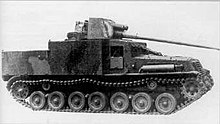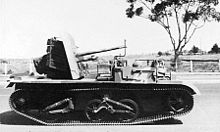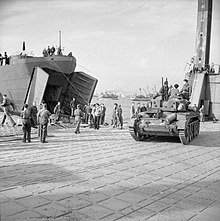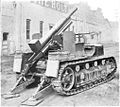Discussion utilisateur:Thib Phil/Bac à sable 17
Artillerie autopropulsée allemande pendant la Seconde Guerre Mondiale[modifier le code]
Origines de l'artillerie autopropulsée[modifier le code]
Artillerie terrestre autopropulsée[modifier le code]
Canons d'assaut[modifier le code]
Chasseurs de char[modifier le code]

Artillerie antiaérienne autopropulsée[modifier le code]
Lance-roquettes[modifier le code]
Waffenträger et autres projets[modifier le code]

Bibliographie[modifier le code]
- Chris Bishop : The Encyclopedia of Weapons of World War II
Liens externes[modifier le code]
- Wikimedia Commons : Film d'époque montrant l'engagement d'un canon autopropulsé Bison pendant la campagne de France
Notes et références[modifier le code]
Notes[modifier le code]
Références[modifier le code]
Artillerie autopropulsée de l'Axe pendant la Seconde Guerre Mondiale[modifier le code]

La Bulgarie fut le seul partenaire de l'Axe a ne point développer une production indigène d'engins d'artillerie autopropulsée, recevant de l'Allemagne des Sturmgeschutz III peu avant sa défection.
Allemagne[modifier le code]
Italie[modifier le code]
Pendant ce conflit, l'Italie aligne deux catégories d'artillerie autopropulsée : les autocannoni, pièces d'artillerie - le plus souvent antiaériennes - montées sur un châssis de véhicules à roues non blindés (camions) et les semonventi sur châssis chenillés et blindés - certains dédiés au rôle de chasseurs de chars ou de canons d'assaut à l'instar des sturmgeschutzen allemands.
Hongrie[modifier le code]
- Canons d'assaut Zrínyi
- Char antiaérien Nimród
Roumanie[modifier le code]
- TACAM R-1
- TACAM R-2
- TACAM T-38
- TACAM T-60
- Chasseur de char Mareșal
Japon[modifier le code]


Le Japon ne vint que tardivement au développement d'une artillerie autopropulsée et peu de véhicules expérimentaux furent finalement produits en série et engagés au combat.
- Chasseur de char et canon autopropulsé Type 1 Ho-Ni
- Canon autopropulsé Type 38/Type 4 Ho-Ro
Bibliographie[modifier le code]
- Chris Bishop : The Encyclopedia of Weapons of World War II
Liens externes[modifier le code]
Notes et références[modifier le code]
Notes[modifier le code]
Références[modifier le code]
Artillerie autopropulsée alliée pendant la Seconde Guerre Mondiale[modifier le code]
Artillerie terrestre autopropulsée[modifier le code]
France[modifier le code]
Royaume-Uni et Commonwealth[modifier le code]

- Bishop Self-Propelled Gun
- Sexton Self-Propelled Gun
États-Unis : Gun Motor Carriages - GMC, Howitzer Motor Carriages - HMC et porte-mortier[modifier le code]
- Halftracks d'artillerie autopropulsée
- Gun Motor Carriages




•T12/M3 75mm GMC - M3 based Gun Motor Carriage equipped with the M1897A5 75 mm gun. These guns were fitted with the gun's M2A3 ground carriage and its gun shield. Later variants featured a purpose-built gun shield (59 rounds). M3A1 75 mm GMC - The M2A2 gun carriage was substituted for the A3, as stocks were exhausted. Later variants featured a purpose-built gun shield.
•T48 57 mm GMC - M3 based Gun Motor Carriage equipped with the M1 57 mm gun, an American copy of the British QF 6 pounder anti-tank gun. A total of 962 T48s were produced during the war. Of these, 60 were supplied under lend lease to Britain, and 650 to the USSR - who called it SU-57 (99 rounds)
- Howitzer Motor Carriages
•T12 HMC - M3 based Howitzer Motor Carriage equipped with the 75 or 105 mm Pack Howitzer by the US Marine Corps.
•T30 75 mm HMC - M3 based Howitzer Motor Carriage equipped with the M1A1 75 mm howitzer in a simple box mount (60 rounds). Used by the US Army. Also provided to the Free French Army, later used in Indochina.
•T38 105 mm HMC - M3 based Howitzer Motor Carriage equipped with the M3 105 mm howitzer. Cancelled with the success of the T19.
- T19 105 mm HMC - M3 based Howitzer Motor Carriage equipped with the M2A1 105 mm howitzer (8 rounds).
- Porte-mortier
•T19/M21 81 mm MMC - M3 based Motor Mortar Carriage equipped with the M1 mortar (81 mm)(97 rounds), designed to allow the mortar to be fired from within the vehicle.
•T21 - M3 based mortar carrier fitted with a 4.2 inch mortar. Never adopted. T21E1 - The T21's mortar could only fire rearward as with the M2 based M4 MMC. The T21E1 reoriented to the mortar to fire forward.
- Engins chenillés
- M7 Priest G.M.C.
- M12 G.M.C.
- M8 H.M.C.
Union Soviétique[modifier le code]
Canons d'assaut[modifier le code]
France : projets et prototypes[modifier le code]
- Somua Sau40
Canon d'assaut dérivé du char de cavalerie Somua S-35 dont il reprend le châssis, son armement principal, à savoir un canon de 75mm APX, est placé dans la caisse, une tourelle d'observation armée d'une mitrailleuse de 7.5mm pour l'autodéfense du véhicule surmontant celle-ci.
- ARL40 V39
Royaume-Uni et Commonwealth[modifier le code]
- Chars CS - Close Support
États-Unis[modifier le code]
Union Soviétique[modifier le code]
Chasseurs de char[modifier le code]
Belgique[modifier le code]
- Chars et chasseurs de char type T13
France[modifier le code]
- Chasseur de char Laffly W 15 TCC
Royaume-Uni et Commonwealth[modifier le code]


- Portees
- Chasseur de chars Archer
- Chasseur de chars Achilles
États-Unis[modifier le code]
Au début du conflit, le 37 mm Gun M3 constitue l'arme antichar de base, entrée en service en 1940. Outre la version tractée, il équipera divers chars de combat dont le char moyen M3 et les chars légers M3 et M5. M6 Fargo
Union Soviétique[modifier le code]

Artillerie antiaérienne autopropulsée[modifier le code]
France[modifier le code]
Royaume-Uni et Commonwealth[modifier le code]


États-Unis[modifier le code]
- Halftracks d'artillerie antiaérienne autopropulsée



- T1E4/M13 MGMC - M3 based Multiple Gun Motor Carriage equipped with the Maxson M33 mount with 2 M2HB machine guns (5,000 rounds). The T1E4 prototypes had the hull sides removed for easy of working with the mount. These were reintroduced on production M13s. This was a development of previous T1s that had all been based on the M2 Half-track Car.
- M14 MGMC - M13 MGMC variant, based on the M5 chassis. Supplied under lend-lease to Britain (5,000 rounds).
- M16 MGMC - M3 based Multiple Gun Motor Carriage equipped with the Maxson M45 Quadmount (more specifically the M45D) with 4 M2HB machine guns (5,000 rounds).
- M16A1 MGMC - Standard M3 Personnel Carriers converted to Multiple Gun Motor Carriages by removing rear seats and installing a Maxson M45 mount (more specifically the M45F, which featured folding "bat wing" gun shields on both sides of the mount over the machine guns). These vehicles are easily identified by the lack of the folding armored hull panels found on purpose-built M16s.
- M16A2 MGMC - M16 MGMC variant, basically M16s brought up to M16A1 standard and with the addition of a rear door to the hull compartment. For existing M16s, this essentially meant a replacement of the M45D mount for the M45F mount.
- M17 MGMC - M16 MGMC variant, based on the M5 chassis. Sent under lend-lease to USSR (5,000 rounds).
- T58 - Similar to the M16/M17, the T58 featured the Maxon quad-mount fitted to a special electric powered turret. Prototype only.
- T28E1 CGMC - M3 based Combination Gun Motor Carriage equipped with one M1A2 37mm autocannon (240 rounds) flanked by 2 M2WC machine guns (3,400 rounds). The original T28 had been based on the shorter M2 Half-Track Car chassis.[1]
- M15 CGMC - T28E1 variant, equipped with an armored superstructure on the turreted mount to provide crew protection, and switched to M2HB machine guns.
- M15A1 CGMC - Reorganization of the weapons, with the M2HB machine guns being fitted under the M1A2 37 mm autocannon instead of above as on the M15.
- T10E1 - Variant to test the feasibility of mounting US made copies of the Hispano-Suiza HS.404 20 mm cannon on modified Maxson mounts. All were later rebuilt as M16s. The original T10 was based on the shorter M2 Half-Track Car chassis.
- 40 mm Experiments - Various attempts were made to mate the 40 mm Bofors L/50 gun to the M3 chassis. In all cases the weapon's recoil was too severe or the mounting too heavy, and the attempts were finally stopped with the adoption of the M19 MGMC on the M24 light tank chassis.
- T54/E1 - Tested in 1942, the gun mount quickly proved to be unstable when fired, and the improved T54E1, which also added a circular armored shield and rear armor to the vehicle, could not fix the inherent problem. Prototype only.
- T59 - A development of the T54/E1, fitted with outriggers to help stabilize the vehicle during sustained firing. Still proved to be too unstable for anti-aircraft use. Prototype only.
- T59E1 - T59 fitted with the T17 fire control system. Prototype only.
- T60/E1 - Similar to the T54 and the T59, but featured two .50 caliber M2 machine guns flanking the 40 mm cannon (the mounting's designation was T65). The T60E1 featured an armor configuration similar to that of the T54E1. Suffered from the same stability issues of previous attempts. Prototype only.
- T68 - Perhaps the most radical of the experiments, the T68 featured two 40 mm cannons, one mounted on top of the other, plus a stabilizer on top of the two guns. The recoil force proved to be too much for the mount, and the idea was abandoned. Prototype only.
- M15 "Special" - Field conversions by US Army depots in Australia of standard M3s, not M15s, fitted with turreted 40 mm Bofors L/50 guns. These were the only successful mating of this weapon to the M3 chassis, and were used more for direct fire support than for anti-aircraft purposes.
- M19 Gun Motor Carriage 40mm Anti-Aircraft :doc
- Projets et prototypes
Union Soviétique[modifier le code]
Lance-roquettes[modifier le code]
France[modifier le code]
Royaume-Uni et Commonwealth[modifier le code]
États-Unis[modifier le code]
Union Soviétique[modifier le code]
Bibliographie[modifier le code]
- Chris Bishop : The Encyclopedia of Weapons of World War II
Liens externes[modifier le code]
Notes et références[modifier le code]
Notes[modifier le code]
Références[modifier le code]
- "Hit-Run Ack-Ack Guns Mounted on Half-Track" Popular Mechanics, December 1943 and "cover artwork"
Histoire de l'artillerie autopropulsée[modifier le code]

De l'Antiquité au XXème siècle[modifier le code]
Naissance de l'artillerie ferroviaire[modifier le code]
Premiers essais[modifier le code]
Débuts de l'artillerie antiaérienne autopropulsée[modifier le code]

Première Guerre mondiale[modifier le code]

- Artillerie automobile
- Apparition de la chenille
- Les premiers « canons d'assaut »
Le Renault FT17 75BS, canon autotracté avec un 75 mm BS (Blockhaus Schneider) produit à au moins 39 exemplaires.
- Les débuts de l'artillerie autopropulsée chenillée
C'est aux Britanniques qu'échut en fait l'initiative du développement de l'artillerie autopropulsée chenillée avec la mise en service du Gun Carrier Mark I armé d'un obusier de 60pdr en 1916-1917. À cette époque en effet, le major Gregg, un officier ingénieur travaillant pour le principal industriel impliqué dans la construction du Tank Mark I (Metropolitan, Carriage, Wagon and Finance) proposa la construction d'une mule mécanique utilisant des éléments du Mark I. La production d'un prototype fut approuvée dès le 5 juin 1916; l'étude commençant en juillet. Le premier prototype fut présenté au Tank Trials Day tenu à Oldbury le 3 mars 1917. Une commande de cinquante engins fut placée auprès des usines Kitson & Co. de Leeds et la livraison aux troupes débuta en juin pour se terminer le mois suivant.
En dépit du réel succès de l'engin, celui-ci resta le seul de son genre sur les champs de bataille de la Première Guerre mondiale, les autorités militaires tant des nations alliées que des empires centraux préférant dans l'immédiat se focaliser sur le développement du char d'assaut.
The British Gun Carrier Mark I was the first example of a self-propelled gun, fielded in 1917 during World War I. It was based on the first tank, the British Mark I and carried a heavy field gun. The gun could either be fired from the vehicle, or removed and set up as normal. In effect the carrier replaced the use of a separate horse team or internal combustion engine powered artillery tractor, and allowed a new way for the gun to be used. (note trad article angl)
-
Le Gun Carrier Mk I - 60pdr britannique.
Projets de l'entre-deux-guerres[modifier le code]
- 240mm Caterpillar Mark IV Self-Propelled Howitzer (États-Unis, 1920): Les obusiers de gros calibre de la Première Guerre Mondiale nécessitaient d'importants convois pour leur déplacements - le plus souvent en pièces détachées, et un personnel nombreux pour leur service, leur installation prenant beaucoup de temps, ce qui en réduisait parfois l'efficacité et les rendaient facilement repérables par l'observation aérienne. Leur repli en cas de tirs de contre-batterie ou d'attaque aérienne s'en trouvait également fortement rallongé, entraînant parfois de ce fait leur destruction ou leur abandon[1].
- Birch Gun (Royaume-Uni, 1925) :
Seconde Guerre mondiale[modifier le code]
At the outbreak of World War II virtually all artillery was still being moved around by artillery tractors or horses. While the German Blitzkrieg doctrine called for combined-arms action, which required fire support for armoured units, during the invasion of Poland and France this was provided by the Luftwaffe using Stuka dive-bombers effectively acting as artillery. Conventional towed howitzers followed. (notre trad article angl)
Axe[modifier le code]

Nations alliées[modifier le code]

Guerre Froide[modifier le code]
URSS et Pacte de Varsovie[modifier le code]
OTAN[modifier le code]

- États-Unis
- Royaume-Uni
- France
Autres nations[modifier le code]
- Suède

- Israel

Époque contemporaine[modifier le code]
Bibliographie[modifier le code]
- François Vauvillier: 1916-18 Des chenilles pour le 75, GBM n° 89, octobre/novembre 2009 pp.68-79
Liens externes[modifier le code]
Notes et références[modifier le code]
Références[modifier le code]
Notes[modifier le code]
en:Industrial warfare[modifier le code]
Voir Wikipédia:Le Bistro/2 mai 2013 pour le titre en français








